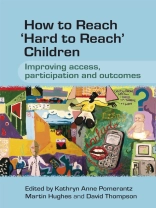It is now widely acknowledged that the most vulnerable and at risk children are children whom the current systems of education, care and health (especially mental health) are failing. The problem of dealing with ‘at risk’ children is also a problem of definition as one service provider s definition might often reflect an entirely different social reality from another’s. Bringing years of collaborative expertise across many disciplines to the problem, the authors of How to Reach ‘Hard to Reach’ Children demonstrate how it is possible for all children to meet the following criteria of staying safe, enjoying and achieving, being healthy, making a positive contribution, and economic well-being.
Tabella dei contenuti
List of contributors.
Preface.
Introductory Chapter Every Child Matters: Setting the Context for the ‘Hard to Reach’ (Martin Hughes).
1 Underachieving Pupils, Underachieving Schools: What Pupils Have to Say (Lynn Turner).
2 Impression Management: Understanding and Enabling Children’s Perception of Competence (Stephanie James).
3 Containing the Emotional Needs of Adolescent Boys ‘at Risk of Exclusion’ in Mainstream Schools (Kathryn Anne Pomerantz).
4 What Works in Reintegration Following Exclusion: Supporting the Parts Only Peers can Reach (Jackie Lown).
5 ‘Hard to Reach’ Migrant Children (Peter Lloyd Bennett and Jane Reid).
6 A Seminar Approach to Multi-Agency Collaboration, Team Building and Therapeutic Group Problem-Solving Where Some Attendees Might be Described as ‘Hard to Reach’ (Michael Pomerantz).
7 Reaching Pupils on the Autistic Spectrum: Parents’ Experiences, Provision and ‘Professional Reachability’ (Brian Willis).
8 Exploring Joined-up Solutions for a Child with Complex Needs (Heather Northcote).
9 Engaging the Hardest to Reach Parents in Parenting-Skills Programmes (Nicola Mc Grath).
10 Whose Voice is it Anyway? (Mary Chilokoa and Jane Mc Kie).
Concluding Chapter Validating and Using Children’s Views: Professional Dilemmas about Working Inside Agencies (David Thompson and Jo Holt).
Glossary.
Appendix 1 Bibliography of Key Documents.
Appendix 2 Searching for Explanations and Responsibilities as to Why Some Clients May be ‘Hard to Reach’.
Appendix 3 Developing Good Practice with ‘Hard to Reach’ Children and Families.
Index.
Circa l’autore
Kathryn Anne Pomerantz, UK. Specialist Senior Educational Psychologist, Derbyshire County Council Educational Psychology Service seconded to the post of Co-Course Director MSc Educational Psychology and Doctor of Educational Psychology, The University of Sheffield. Chartered Educational Psychologist. Member of the Ed D Educational Psychology Course Sheffield University.
Martin Hughes, UK. Senior Educational Psychologist, Sheffield City Council. Chartered Educational Psychologist. Member of the Ed D Educational Psychology Course, Sheffield University.
Dr David Thompson, UK. Senior Lecturer in Educational Psychology, Co-Director Ed D Educational Psychology, School of Education, University of Sheffield. Chartered Educational Psychologist. British Psychological Society (Associate Fellow)












